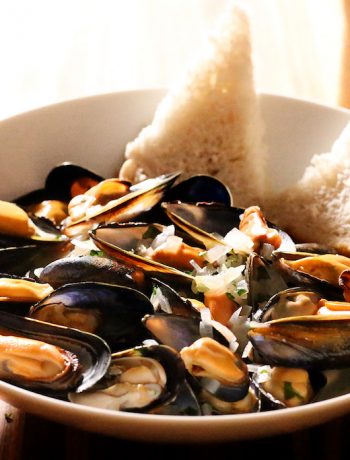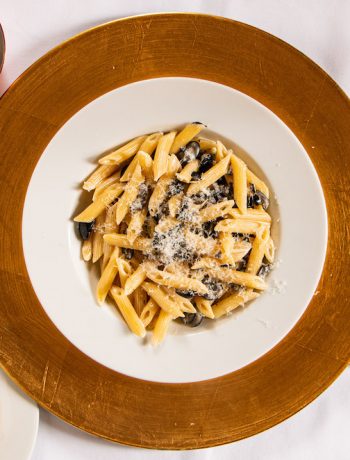Tatties an’ herrin’ is basically a lost dish. When herring fishing was riding high before the fishing ban in 1977, Britain was a nation 30 years beyond a war, only 20 years past rationing, and those responsible for putting food on the table were born in the 1930s. In those days, and the 200 or so years before, Scotland was biologically powered by potatoes cooked with salt herring and onions. They even sang about it:
Tatties an’ herrin’
Your hardworking Scotsman’s gone crazy I fear
Each day ye maun hae your bit beef and your beer
But ye dinna ken though you’re maybe no’ carin’
Your natural food is tatties and herrin’
Tatties and herrin’, tatties and herrin’
Your natural food is tatties and herrin’
Wi’ a pound in the week ye maun aye be content
Ten bob tae lay by for the claes and the rent
Half a croon o’ yer ain will ye aye can be sparin’
And seven and sixpence for tatties and herrin’
Tatties and herrin’, tatties and herrin’
And seven and sixpence for tatties and herrin’
When the Queen wanted someone tae fecht wi’ her foes
It wisna awa tae the lowlands she goes
But awa tae the hills o’ the brave and the darin’
The lads that were brought up on tatties and herrin’
Tatties and herrin’, tatties and herrin’
The lads that were brought up on tatties and herrin’
I speak a bit of Doric/Scots (not that there is much in this), and I can tell you that the song translates to: Stop worrying about getting beef and other fancy shit, and just eat tatties and herring. It’s cheap, and when the Queen wants to start a war, she will go find lads who were built of tatties and herring.
Incidentally, we first thought that the inclusion of ‘The Queen’ in this song would date it as post 1953 (i.e Elizabeth II). But we received a comment from folk music fan Marina Fournier (see below) who pointed out a missing verse that relates the the Scots meeting the Russians at Alma Heights. The Battle of the Alma was during the Crimean War, so the Queen is question is Victoria.
When we researched and wrote about silver darlings, we kept running into this legendary dish, but we never found a recipe with information more than a vague list of ingredients – and even those recipes seemed to vary in the way that the actual fish was prepared. The formula we eventually found was from Anette Hope’s A Caledonian Feast. This book is stuffed with very traditional recipes originally cooked by feudal, rag-tag peoples standing on the cold, sodden Northern frontier of the Roman Empire. Hope updated the dish to fresh herring, presumably because salt herring is hard to come by these days. But you can make our salt herring recipe and try the real thing. And we suggest you do because salt herring is so much firmer than fresh, and it provides a fantastic textural counterpoint to the soft tatties.
Our diligence to the original recipe for tatties an’ herrin’ could mean that, in terms of the modern, Internet age, ours is the most authentic, Google-accessible recipe for the dish anywhere. When we first cooked this meal, we thought it might be too rustic and simple for public consumption. It is both those things, but it is also absolutely beautiful to eat. Go make it and taste the history of coastal Scotland.
Tatties an' herrin'
Ingredients
- 8 salt herring fillets (see this site for a method for making those)
- 450g potatoes, washed, unpeeled and thickly sliced
- 2 onions, thinly sliced
- 50ml milk
- Sea salt and freshly ground black pepper
Instructions
Grease a sauté pan with butter and cover with bottom with half the potatoes. Then add half the onion, and the herring. Season.
Add another layer of onions and potatoes to top. Season again.
Pour in the milk and set the pan over a flame to just boil. Cover and cook on a very low heat for 1 hour until the potatoes are done.






7 Comments
A. Marina Fournier
25/07/2019 at 9:34 amThe Queen is actually Victoria. Because you didn’t have the verses below, yours was a logical conclusion.
On Alma’s Heights noo the Russians said:
“We were forced tae tak’ wyss for the kilt an’ the plaid,”
But they didnae ken ’twas the brave an’ the darin’,
The lads that were fed upon tatties and herrin’.
When
the harbour o’ refuge was first spoken aboot
Aiberdeen and Stonehaven they were fairly pit oot,
For the Queen kent the convicts wid get their best farin’
Upon Buchan tatties an’ Peterheid herrin’.
Info on the song’s origin, and more complete lyrics can be found here:
https://mainlynorfolk.info/folk/songs/tattiesanherrin.html
I heard it from Old Blind Dogs. I like to know who wrote songs, especially the ones that *sound* traditional.
The late Andy M. Stewart, songwriter and lead vocals for Silly Wizard, had a gift for writing songs you’d swear were traditional, as does Brian McNeill, one of the founding members of Battlefield Band.
I must try this recipe!
Food and history—I can get behind that! Two of my favourite subjects, along with folk song, language and languages, and medical news &c.
Nigel Eastmond
25/07/2019 at 4:27 pmThanks Marina. I have added your information to the article. As for making the dish, by all means try it. It does taste of something from the past. Seasoning is quite important.
A. Marina Fournier
27/07/2019 at 9:27 amSeasoning is always important, in my experience.
David Sutherland
06/02/2022 at 2:53 pmI am the son of parents from Caithness. My memory of tatties and herring is that they would simply fry fresh herring coated in oatmeal, accompanied with boiled potatoes – and Coleman’s mustard. Your recipe sounds much better!
You might be interested in my website about the herring trade.
I notice that you missed out the last verse of the song, which alluded to the fact that the inmates of Peterhead Prison would be fed on tatties and herring.
Nigel Eastmond
07/02/2022 at 8:26 amThanks for this. I thing the difference in the recipes is age. The cured herring is a very old method of handling it, and it took me some time to work out how it was done, because nobody had written down the method for any quantity of herring less than ‘one barrel.’ That lack of information and practiced skill would mean that most domestic kitchens in Scotland would follow the pattern of your parents. I presume they will have dipped the fish in milk before the oatmeal?
Don
18/06/2022 at 1:11 amI found myself here after eating tatties and herring tonight for the first time in a couple (maybe more) of years. Milk isn’t necessary if you’re using properly fresh herring (my wife tells me that tonight, she used flour/egg but, for me, pressing it into the oatmeal is enough. The oatmeal doesn’t just complement the flavour, it provides a mastication aid for the feathery bones. Much as I love mustard (and have eaten many German/Dutch herring/mustard combos), Colman’s seems a bit strong for herring – maybe I’ll try some Dijon one day. As for the tatties, well, if they’re not ‘Groats tatties, for example: https://www.facebook.com/Harroldbros/posts/2664619243826407/
or if you would prefer a pish context link: they’re just a substitute https://www.youtube.com/watch?v=eswQl-hcvU0
Nigel Eastmond
30/06/2022 at 2:06 pmAye, Don, but there is the thing. Traditional tatties and herring does not use fresh herring – it uses salt-cured herring.